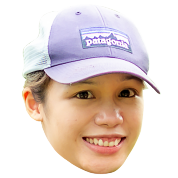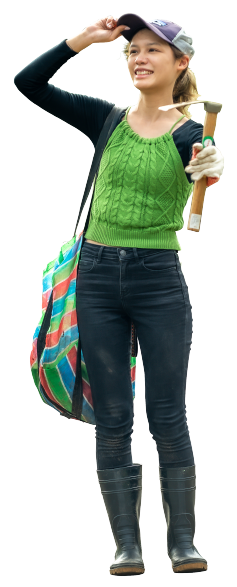Have you any handicraft experiences in the past? What impressed you most in the handicraft class today?

I am not very good at handicrafts and can barely handle things like sticking together pieces of wood to make a flying squirrel, ones with simple instructions. I do not have a lot of patience in handicrafts, so I am not good at it. Drawing is the only thing I like to spend time on.
But I was really good at shaving bamboo slices for the wind whistle today, I had no idea that I could shave! It’s a good thing the flying squirrel leather ornament was not difficult, otherwise, the instructor would have had a very tough time working with me. Like when we have to pierce holes along the edges of the leather for tanning, I completely messed it up. It is not something I am used to, the force was applied wrongly, and that messed up the line of holes, it’s a good thing Voyu could fix it in the end.
How did it feel processing animal skin?

Voyu is amazing, I worship him. I kept comparing myself to him along the way, because, in the past, similar cultural experience tours were led by elders, you rarely have youth my age leading very untouristy tours, which proves that Voyu really understands the essence of these things.
The Bunun also has a tanning craft. In recent years, with people awakening culturally, some youths have started to revitalize this culture. I do not go back to visit as much, so I have not had much exposure to it. There are too many things to learn as a hunter, the skin is just a small part of the hunter’s knowledge system. There is plenty more where we can’t see. I admire people with a sense of mission and are willing to talk about it and share with people the traditional cultures.
Also, there is the “scent”. When I visited my Atayal grandparents in my childhood, I always felt that the kitchen had a kind of scent that was never found in Non-indigenous kitchens, and I could always tell right away by the scent whether it is the kitchen of an indigenous person. But as a child, I did not know where that scent came from. I did not realize until just then that it was the scent of the game.
What did you have to play with as a child?

Tamagotchi, play catch, barbie dolls, cars...when you let a child go outside, they will play with whatever they can lay their hands on. I have never played with “traditional indigenous toys” in the past, I didn’t have friends who played with them growing up.
After I transferred to a city school, I noticed that students there did not climb trees as much. When I was in first grade, I still lived in the mountain and there were always trees outside our houses. I loved climbing up high and just staring out in the open and contemplating or playing by myself. Sometimes when my dad came home to see that I was not home, he would assume that “Umav is probably on a tree again.” My aunt nearby kept chickens back then, in addition to the broiler, there were beautiful and colorful bantams in many colors. These chickens did not like staying on the ground, they liked to spend time in the trees like me. I remember once sharing with my non-indigenous classmates about it, “I came home and saw all of our chickens on the tree, looking very happy.” I told it very matter-of-factly, but everyone thought the story was weird. I later looked it up and found that not everyone’s chicken enjoyed being on the tree.
 I met and talked with 5 instructors in the short span of 3 days, and I cherish every moment of it. In the fields of Yumi e Yakumangana at Taso ci Cou, she patiently introduced to me all the plants before us and the corresponding farming knowledge, while I kept worrying about stepping in the wrong places and chopping on the wrong things. When I was harvesting sweet potatoes, I made fun of myself and said that I have eaten many but never harvested a single one. Yumi was very nice and said to me, “you are not alone, there are many like you,” which makes me feel better about not knowing a thing about farming. I admire her for being able to operate an all-natural, organic, and innocuous farm in the mountain, work in the production and marketing group, and still be able to host study tours from the plains at the same time.
I met and talked with 5 instructors in the short span of 3 days, and I cherish every moment of it. In the fields of Yumi e Yakumangana at Taso ci Cou, she patiently introduced to me all the plants before us and the corresponding farming knowledge, while I kept worrying about stepping in the wrong places and chopping on the wrong things. When I was harvesting sweet potatoes, I made fun of myself and said that I have eaten many but never harvested a single one. Yumi was very nice and said to me, “you are not alone, there are many like you,” which makes me feel better about not knowing a thing about farming. I admire her for being able to operate an all-natural, organic, and innocuous farm in the mountain, work in the production and marketing group, and still be able to host study tours from the plains at the same time.
Sayungu moved to Niahosa after she got married and had always had an interest in leather carving. She likes to create with elements from her home surrounding such as landscapes or animals, and sometimes she teaches leather carving. But when it comes to commercializing her products, she smiled and said that she prefers to create as she is inspired, if she made products for commercial purposes, she would have to adapt to the preferences of the customers or invest greatly in manpower. As an illustration content creator, I can relate to her. Do we want to make more money, or do we want to create what makes us happy? That is the question. I complimented her on “being a true artist”.
Pasuya, Grandpa Mo’o, and Voyu the home-returning youth, the three Tsou men from different generations also inspired me greatly. First of all, Pasuya’s knowledge and his sense of mission for the Tsou culture are admirable, and I am extremely grateful to Grandpa Mo’o for being willing to spend time sharing their history and culture with me, someone who is not Tsou. I often compare what I learned here with my past experiences in luhtu/Mahavun community, or with the Bunun and Atayal cultures. From their stories, we heard the names Uyong? Yata’uyungana and Lixin Wadan, and upon further inquiry, we learned that compared to the Japanese colonization, the real colonial harm done to the entire Tsou community was the authoritative party state ruling which ruthlessly deprived the Tsou of their lives and dignity. They did not deliberately stir up strong emotions nor avoid talking about specific details when mentioning the past, but with the history blatantly revealed before us, my heart throbbed with sentiments.
This place was renamed Niahosa when Uyong? Yata’uyungana guided his people in relocation. According to oral history and archaeological data, this place was originally the old settlement of another indigenous group, which is the origin of the geographic name Niahosa in the Tsou language. Pasuya mentioned that the name of the indigenous group no longer in existence is “taqupu-aneu”. From research, I discovered that this place was known as the former territory of Takipulan, the now disappeared Bunun community, and as a Bunun, I feel that fate has brought me here.
Inheriting the expectations and nurturing of his predecessors, Voyu picks up the cultural preservation work. He is a member of the local band which creates original music in the Tsou language and can converse with elders in fluent Tsou language with a level of confidence and firmness that people his age can only aspire to (even though he is always humble about his fluency). When I asked him why he uses his Tsou name on his official ID, he said that he does not expect the same of everyone, but for him, “this is my name, so I think it’s only natural”. That kind of natural confidence, humility, and never forgetting to honor the forest and ancestors are my most important takeaway from this journey.
2022.11.14





